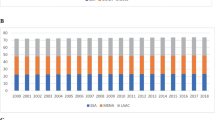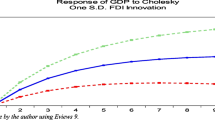Abstract
This study highlights the responsiveness of import demand in the context of aggregate expenditure components in Pakistan over the period of 1974–2009. The study uses Johansen multivariate cointegration analysis and estimates an error correction model to drive the long-run and short run elasticities of the import demand behavior. The cointegration results provide a strong empirical validity of the presence of long run elasticities between import and macro-components. In the long-run, the consumption expenditure is the main dominant determinants of the movements in import demand in Pakistan. In the short-run, the consumption and investment expenditures are the major determinants of import demand while the import demand is not sensitive to relative price. Moreover, the parameter stability tests confirm the stability of the model, and the sensitivity analysis confirms the robustness of initial results.



Similar content being viewed by others
References
Abbott AJ, Seddighi HR (1996) Aggregate imports and expenditure component in UK: an empirical analysis. Appl Econ 28:1119–1125
Afzal M (2007) Exchange rate response of import demand in Pakistan. Sarhad J Agric 23(4):1181–1186
Agbola FW, Damoense MY (2005) Time series estimation of import demand functions for pulsed in India. J Econ Stud 32(2):146–157
Alias MH, Cheong TT (2000) Aggregate imports and expenditure components in Malaysia: a cointegration and error correction analysis. ASEAN Econ Bull 17:257–269
Alias MH, Tang TC, Othman J (2001) Aggregate import demand and expenditure components in five ASEAN countries: an empirical study. Jurnal Ekonomi Malaysia 35:37–60
Brown RL, Durbin J, Evans JM (1975) Techniques for testing the constancy of regression relationships over time. J Roy Stat Soc B 37:149–163
Chani MI, Chaudhary AR (2010) Import demand behavior in Pakistan: an empirical analysis. LAP Lambert Academic Publishing AG & Co. KG, Saarbrücken
Constant NBZS, Yue Y (2010) An econometric estimation of import demand function for Cote D’Ivoire. Int J Bus Manag 5(2):77–84
Fosu OAE, Magnus FJ (2008) Aggregate import demand and expenditure components in Ghana. J Soc Sci 4(1):1–6
Funke K, Nickel C (2006) Does Fiscal policy matter for the trade account? A panel cointegration study. IMF working paper aeries No. 620 http://www.ecb.int/pub/pdf/scpwps/ecbwp620.pdf
Giovannetti G (1989) Aggregate imports and expenditure components in Italy: an econometric analysis. Appl Econ 21(7):957–971
Goldstein M, Khan MS (1985) Income and price effects in foreign trade. Handbook of international economics 2:1041–1105
Government of Pakistan (2008–2009) Economic Survey of Pakistan, Ministry of Finance, Islamabad
Gujarati DN (2003) Basic econometrics, 4th edn. McGraw-Hill, New York
Ho WS (2004) Estimating Macao’s import demand functions. Monetary Authority of Macao. http://www.amcm.gov.mo/publication/quarterly/Jul2004/IMdemand_en.pdf
International Monetary Fund (2009) International financial statistics (IFS) online database. International Monetary Fund, Washington
Johansen S (1988) Statistical analysis of cointegration vectors. J Econ Dyn Control 12(2–3):231–254
Johansen S, Juselius K (1990) Maximum likelihood estimation and inference on cointegration with applications to the demand for money. Oxford Bull Econ Stat 52:169–210
Kotan Z, Saygili M (1999) Estimating an import demand function for Turkey. The central bank of The Republic of Turkey. Discussion Paper No. 9909
Levine R, Renelt RD (1992) A sensitivity analysis of cross country growth regression. Am Econ Rev 82(4):942–963
Min BS, Alias MH, Tang TC (2002) An analysis of South Koreas import demand. J Asia Pac Aff 4(1):1–17
Narayan S, Narayan PK (2005) An empirical analysis of Fiji’s import demand function. J Econ Stat 32(2):158–168
Oner G, Burc U (2008) Aggregate import and expenditure components in Turkey theoretical and empirical assessment MPRA Paper No. 9622 (http://mpra.ub.uni-munchen.de/9622)
Sims CA (1980) Macroeconomics and reality. Econometrica 48(1):1–49
Sinha D (1997) Determinants of import demand in Thailand. Int Econ J 11:73–83
State Bank of Pakistan (2010) Hand book of statistics on Pakistan economy. Central Directorate State Bank of Pakistan, Karachi
Tambi NE (1998) Trade liberalization effects on commodity imports in Cameroon. J Econ Stud 25(3):193–202
Tang TC (2003) An empirical analysis of China’s aggregate import demand function. China Econ Rev 14:142–163
Yin F, Hamori S (2011) Estimating the import demand function in the autoregressive distributed lag framework: the case of China. Econ Bull 31(2):1576–1591
Author information
Authors and Affiliations
Corresponding author
About this article
Cite this article
Majeed, S., Waheed, A. Analyzing the Import Demand Function with Expenditure Components: Evidence from Pakistan. Transit Stud Rev 19, 245–259 (2012). https://doi.org/10.1007/s11300-012-0236-4
Published:
Issue Date:
DOI: https://doi.org/10.1007/s11300-012-0236-4




